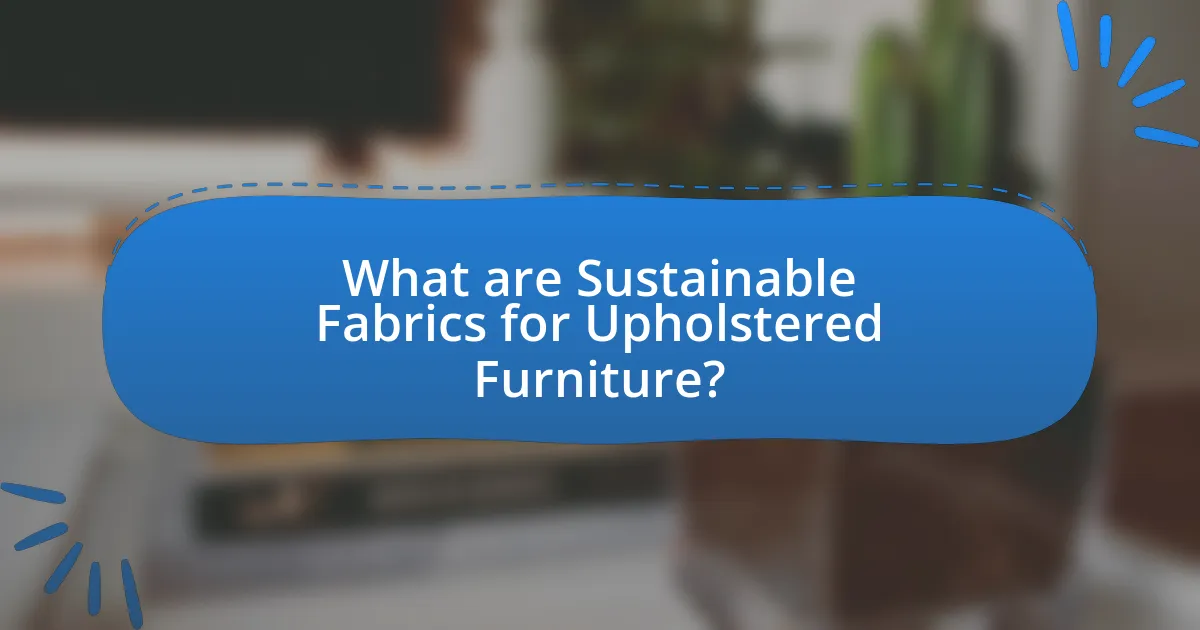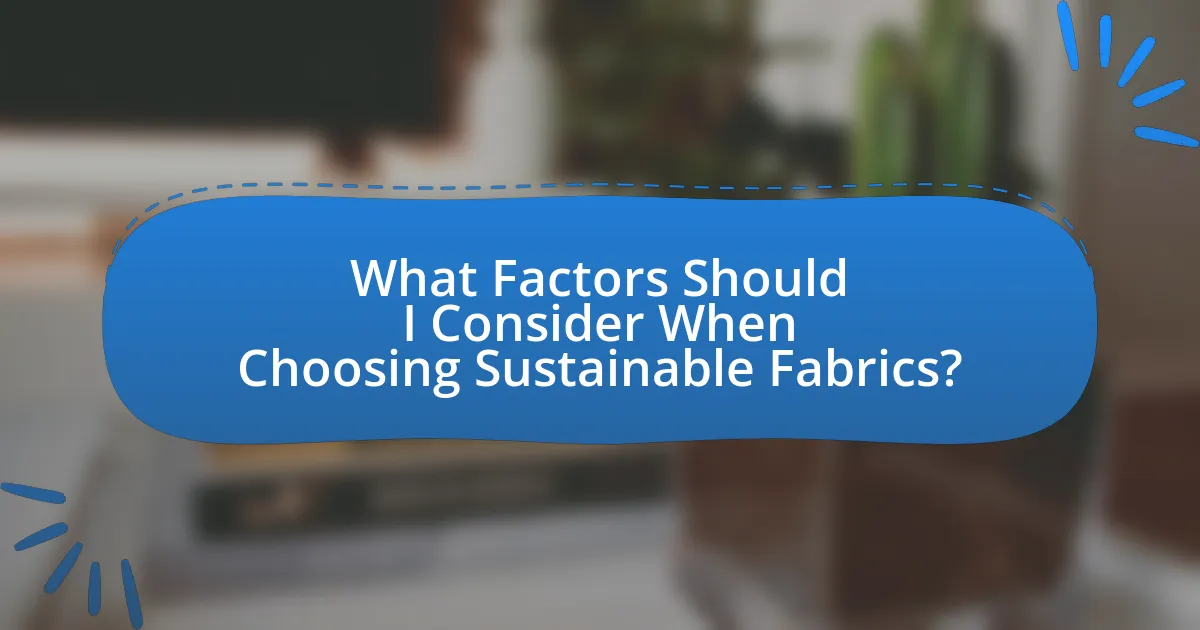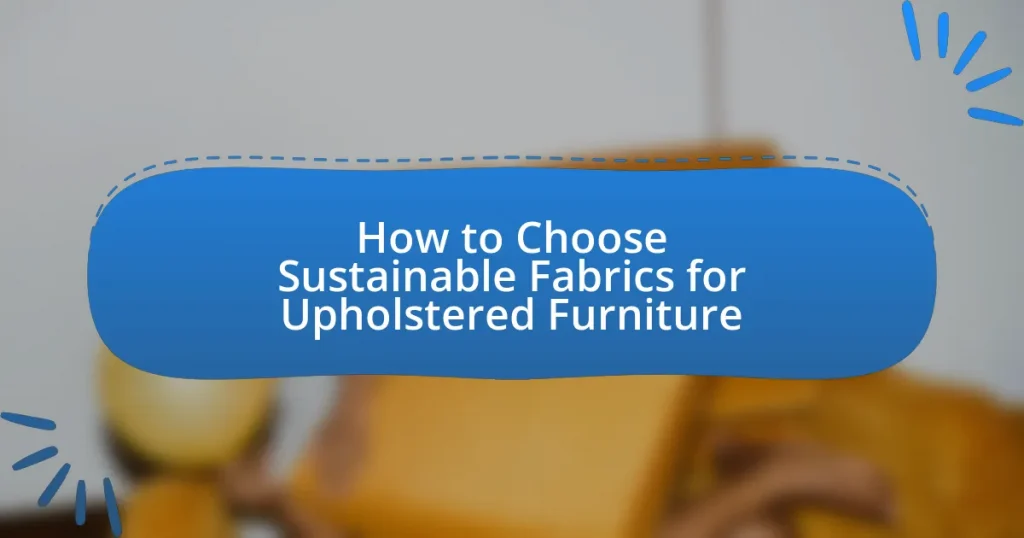Sustainable fabrics for upholstered furniture are materials produced with minimal environmental impact, including organic cotton, linen, hemp, recycled polyester, and Tencel. These fabrics differ from conventional options by utilizing renewable resources and eco-friendly production processes, which reduce pollution and waste. The article outlines the importance of sustainable sourcing, the environmental benefits of using such fabrics, and how consumer demand influences the market. It also provides guidance on identifying sustainable fabrics through certifications, factors to consider when choosing them, and practical tips for selecting the best options for furniture.

What are Sustainable Fabrics for Upholstered Furniture?
Sustainable fabrics for upholstered furniture are materials that are produced with minimal environmental impact and promote social responsibility. These fabrics often include organic cotton, linen, hemp, recycled polyester, and Tencel, which are sourced from renewable resources or recycled materials. For instance, organic cotton is grown without synthetic pesticides or fertilizers, reducing soil and water pollution, while Tencel is made from sustainably harvested wood pulp and produced in a closed-loop process that recycles water and solvents. The use of these fabrics not only supports eco-friendly practices but also contributes to healthier indoor environments by reducing harmful chemical emissions.
How do sustainable fabrics differ from conventional fabrics?
Sustainable fabrics differ from conventional fabrics primarily in their production processes and environmental impact. Sustainable fabrics are made from renewable resources, such as organic cotton or recycled materials, which reduce reliance on non-renewable resources and minimize waste. In contrast, conventional fabrics often utilize synthetic fibers derived from petroleum, contributing to environmental degradation and pollution. For example, the production of polyester, a common conventional fabric, emits significant greenhouse gases and consumes large amounts of water. Additionally, sustainable fabrics typically employ eco-friendly dyes and processes that reduce harmful chemical usage, whereas conventional fabrics may involve toxic chemicals that can harm ecosystems. This distinction highlights the importance of choosing sustainable options for reducing environmental footprints in the textile industry.
What materials are considered sustainable for upholstery?
Sustainable materials for upholstery include organic cotton, linen, hemp, recycled polyester, and leather alternatives made from plant-based sources. Organic cotton is grown without synthetic pesticides or fertilizers, reducing environmental impact. Linen, derived from the flax plant, requires less water and energy to produce. Hemp is a fast-growing crop that enriches the soil and needs minimal resources. Recycled polyester, made from post-consumer plastic bottles, diverts waste from landfills and reduces reliance on virgin materials. Plant-based leather alternatives, such as those made from pineapple leaves or mushrooms, offer eco-friendly options that minimize animal product use and environmental harm.
Why is the sourcing of materials important in sustainability?
The sourcing of materials is crucial in sustainability because it directly impacts environmental health, resource conservation, and social responsibility. Sustainable sourcing ensures that materials are obtained in a way that minimizes ecological damage, such as deforestation and pollution, while promoting the use of renewable resources. For instance, according to the World Resources Institute, sustainable sourcing practices can reduce greenhouse gas emissions by up to 30% in the textile industry. Additionally, ethical sourcing supports fair labor practices and community development, which are essential for social sustainability. Therefore, responsible material sourcing is foundational for achieving overall sustainability goals in industries like furniture upholstery.
What are the environmental benefits of using sustainable fabrics?
Sustainable fabrics provide significant environmental benefits by reducing resource consumption and minimizing pollution. These fabrics are often made from renewable resources, such as organic cotton or hemp, which require less water and pesticides compared to conventional materials. For instance, organic cotton uses 91% less water and 62% less energy than traditional cotton production. Additionally, sustainable fabrics often involve eco-friendly manufacturing processes that emit fewer greenhouse gases and generate less waste. According to the Textile Exchange, using recycled fibers can save up to 70% of the energy required to produce new fibers, further decreasing the overall environmental impact.
How do sustainable fabrics impact carbon footprint?
Sustainable fabrics significantly reduce carbon footprint by utilizing eco-friendly materials and production processes. These fabrics often come from renewable resources, such as organic cotton or hemp, which require less energy and water compared to conventional textiles. For instance, organic cotton farming can reduce carbon emissions by up to 46% due to the absence of synthetic fertilizers and pesticides. Additionally, sustainable fabrics often involve less energy-intensive manufacturing methods, further decreasing greenhouse gas emissions. By choosing sustainable fabrics, consumers can contribute to a lower overall carbon footprint in the textile industry.
What role do sustainable fabrics play in reducing waste?
Sustainable fabrics play a crucial role in reducing waste by minimizing the environmental impact associated with textile production and disposal. These fabrics are often made from renewable resources, recycled materials, or organic fibers, which significantly decrease the amount of waste generated during manufacturing. For instance, using recycled polyester can divert plastic waste from landfills, as it repurposes existing materials instead of relying on virgin resources. Additionally, sustainable fabrics typically have a longer lifespan and are designed for durability, which reduces the frequency of replacement and, consequently, the overall waste produced in the furniture industry.
Why is it important to choose sustainable fabrics for upholstered furniture?
Choosing sustainable fabrics for upholstered furniture is important because it reduces environmental impact and promotes ethical production practices. Sustainable fabrics, such as organic cotton or recycled polyester, minimize the use of harmful chemicals and reduce waste, contributing to a healthier ecosystem. For instance, the production of conventional cotton uses approximately 16% of the world’s insecticides, which can harm biodiversity. By opting for sustainable materials, consumers support practices that protect natural resources and promote social responsibility in the textile industry.
How does consumer demand influence the market for sustainable fabrics?
Consumer demand significantly influences the market for sustainable fabrics by driving manufacturers to prioritize eco-friendly materials and production processes. As consumers increasingly seek environmentally responsible options, brands respond by expanding their offerings of sustainable fabrics, such as organic cotton, hemp, and recycled polyester. According to a 2021 report by Grand View Research, the global sustainable fabrics market is projected to reach $85 billion by 2027, reflecting a compound annual growth rate of 9.7%. This growth is largely attributed to rising consumer awareness regarding environmental issues and a preference for products that align with sustainable practices. Consequently, the shift in consumer preferences not only shapes product availability but also encourages innovation in sustainable textile technologies.
What are the long-term benefits of investing in sustainable upholstery?
Investing in sustainable upholstery offers long-term benefits such as reduced environmental impact, enhanced durability, and improved indoor air quality. Sustainable upholstery materials, often made from organic or recycled fibers, minimize the use of harmful chemicals and reduce waste, contributing to a healthier planet. Additionally, these materials tend to be more durable than conventional options, leading to longer-lasting furniture that requires less frequent replacement. This durability not only saves money over time but also decreases the frequency of resource consumption associated with manufacturing new products. Furthermore, sustainable upholstery often features low-VOC (volatile organic compounds) emissions, which contribute to better indoor air quality, promoting a healthier living environment.

How to Identify Sustainable Fabrics?
To identify sustainable fabrics, examine the material’s origin, production process, and certifications. Sustainable fabrics are often made from organic or recycled materials, such as organic cotton, linen, hemp, or recycled polyester, which reduce environmental impact. Additionally, look for certifications like Global Organic Textile Standard (GOTS) or OEKO-TEX, which ensure adherence to environmental and social standards. Research indicates that organic cotton uses 91% less water than conventional cotton, highlighting the resource efficiency of sustainable options.
What certifications should I look for in sustainable fabrics?
Look for certifications such as Global Organic Textile Standard (GOTS), OEKO-TEX Standard 100, and the Responsible Wool Standard (RWS) when selecting sustainable fabrics. GOTS ensures organic status and environmental criteria throughout the textile supply chain, while OEKO-TEX Standard 100 certifies that textiles are free from harmful substances. The Responsible Wool Standard focuses on animal welfare and sustainable farming practices. These certifications provide assurance of sustainability and ethical practices in fabric production.
What do certifications like GOTS and OEKO-TEX signify?
Certifications like GOTS (Global Organic Textile Standard) and OEKO-TEX signify that textiles meet specific environmental and safety criteria. GOTS ensures that organic fibers are produced sustainably and that the entire textile supply chain adheres to strict ecological and social standards, including the prohibition of harmful chemicals. OEKO-TEX, on the other hand, certifies that textiles are free from harmful substances and safe for human use, focusing on consumer safety and environmental protection. Both certifications provide assurance to consumers that the fabrics they choose are produced responsibly and are safe for use in products like upholstered furniture.
How can I verify the authenticity of these certifications?
To verify the authenticity of certifications related to sustainable fabrics for upholstered furniture, check the issuing organization’s credibility and reputation. Research the certifying body to ensure it is recognized in the industry, such as Global Organic Textile Standard (GOTS) or OEKO-TEX. Additionally, cross-reference the certification number on the fabric label with the certifying organization’s database, which typically lists valid certifications. This process confirms that the certification is legitimate and that the fabric meets the specified sustainability criteria.
What characteristics define a fabric as sustainable?
A fabric is defined as sustainable when it is produced using environmentally friendly processes, made from renewable resources, and designed for durability and recyclability. Sustainable fabrics often utilize organic materials, such as organic cotton or hemp, which are grown without harmful pesticides and fertilizers, reducing environmental impact. Additionally, sustainable fabrics may incorporate low-impact dyes and water-efficient manufacturing processes, further minimizing ecological harm. Research indicates that the fashion industry contributes significantly to pollution, with sustainable practices potentially reducing this impact by up to 30% (Ellen MacArthur Foundation, 2017). Thus, the characteristics of sustainability in fabrics are rooted in their material sourcing, production methods, and end-of-life considerations.
How does the production process affect fabric sustainability?
The production process significantly affects fabric sustainability by determining resource usage, waste generation, and environmental impact. For instance, conventional textile manufacturing often relies on water-intensive processes and harmful chemicals, leading to pollution and depletion of natural resources. In contrast, sustainable production methods, such as using organic materials and eco-friendly dyes, minimize environmental harm and promote resource conservation. According to the Ellen MacArthur Foundation, transitioning to circular production models can reduce textile waste by up to 80%, highlighting the importance of production choices in enhancing fabric sustainability.
What are the indicators of eco-friendly dyeing and finishing processes?
Indicators of eco-friendly dyeing and finishing processes include the use of non-toxic, biodegradable dyes, water-efficient techniques, and the minimization of harmful chemical usage. These processes often utilize natural or organic materials, such as plant-based dyes, which reduce environmental impact. Additionally, eco-friendly dyeing methods may involve closed-loop systems that recycle water and chemicals, significantly lowering waste. Certifications like GOTS (Global Organic Textile Standard) and OEKO-TEX® Standard 100 further validate the sustainability of these practices by ensuring compliance with strict environmental and safety criteria.

What Factors Should I Consider When Choosing Sustainable Fabrics?
When choosing sustainable fabrics, consider the material’s environmental impact, production processes, and certifications. Sustainable fabrics should be made from renewable resources, such as organic cotton or hemp, which require less water and pesticides compared to conventional materials. Additionally, the production processes should minimize carbon emissions and waste; for instance, fabrics dyed with low-impact dyes are preferable. Certifications like Global Organic Textile Standard (GOTS) or OEKO-TEX Standard 100 provide assurance that the fabric meets specific environmental and social criteria, ensuring ethical production practices.
How do durability and maintenance affect the choice of sustainable fabrics?
Durability and maintenance significantly influence the choice of sustainable fabrics by determining their lifespan and the resources required for upkeep. Fabrics that are durable reduce the frequency of replacement, thereby minimizing waste and resource consumption over time. For instance, materials like organic cotton or recycled polyester can offer high durability, which aligns with sustainability goals by extending the life cycle of the product. Additionally, fabrics that require less maintenance, such as those that are stain-resistant or easy to clean, contribute to lower environmental impact by reducing the need for harsh cleaning chemicals and excessive water usage. Research indicates that durable fabrics can last up to five times longer than less durable options, which supports the sustainability ethos by promoting longevity and reducing landfill contributions.
What types of sustainable fabrics are best for high-traffic areas?
The best types of sustainable fabrics for high-traffic areas include organic cotton, hemp, and recycled polyester. Organic cotton is durable and breathable, making it suitable for frequent use, while hemp is known for its strength and resistance to wear, providing longevity in high-traffic settings. Recycled polyester, derived from post-consumer plastic, offers durability and stain resistance, making it practical for areas with heavy use. These fabrics not only meet sustainability criteria but also withstand the demands of high-traffic environments effectively.
How can I maintain the longevity of sustainable upholstery fabrics?
To maintain the longevity of sustainable upholstery fabrics, regularly clean them according to the manufacturer’s guidelines and avoid exposure to direct sunlight, which can cause fading. Regular vacuuming removes dust and debris that can wear down fibers, while spot cleaning with appropriate cleaners prevents stains from setting. Additionally, using fabric protectors can enhance durability by creating a barrier against spills and dirt. Research indicates that proper maintenance can extend the life of upholstery by up to 50%, ensuring that sustainable materials remain functional and visually appealing over time.
What aesthetic considerations should I keep in mind?
When choosing sustainable fabrics for upholstered furniture, consider color, texture, pattern, and overall style. Color influences mood and can enhance or detract from a room’s aesthetic; for instance, neutral tones create a calming effect, while vibrant colors can energize a space. Texture adds depth and interest; fabrics like linen or velvet can evoke different feelings and complement various design styles. Patterns can serve as focal points or harmonize with existing decor, so selecting the right pattern is crucial for visual balance. Lastly, ensure that the chosen fabric aligns with the overall style of the room, whether it be modern, traditional, or eclectic, to maintain a cohesive aesthetic.
How do color and texture influence the selection of sustainable fabrics?
Color and texture significantly influence the selection of sustainable fabrics by affecting aesthetic appeal and tactile experience. The choice of color can impact consumer perception of sustainability; for instance, earthy tones often evoke a sense of naturalness and eco-friendliness, aligning with sustainable values. Texture plays a crucial role in the tactile quality of fabrics, where natural textures, such as linen or organic cotton, are preferred for their comfort and environmental benefits. Research indicates that consumers are more likely to choose fabrics with textures that feel organic and sustainable, as these textures often correlate with lower environmental impact. Thus, both color and texture not only enhance the visual and sensory attributes of sustainable fabrics but also reinforce their eco-friendly characteristics.
What styles of upholstery work best with sustainable fabrics?
Contemporary and minimalist upholstery styles work best with sustainable fabrics. These styles emphasize clean lines and simplicity, allowing the natural textures and colors of sustainable materials, such as organic cotton, hemp, or recycled polyester, to stand out. The focus on functionality and eco-friendliness in contemporary design aligns with the principles of sustainability, making it easier to incorporate fabrics that have a lower environmental impact. Additionally, the use of sustainable fabrics in these styles can enhance the aesthetic appeal while promoting responsible consumption.
What are some practical tips for selecting sustainable fabrics for my furniture?
To select sustainable fabrics for furniture, prioritize materials that are organic, recycled, or made from renewable resources. Organic cotton, linen, and hemp are excellent choices as they are grown without harmful pesticides and chemicals, reducing environmental impact. Additionally, look for fabrics made from recycled materials, such as polyester derived from plastic bottles, which helps divert waste from landfills. Certifications like Global Organic Textile Standard (GOTS) or OEKO-TEX Standard 100 can also guide you in identifying truly sustainable options, as these labels ensure adherence to environmental and social criteria.


